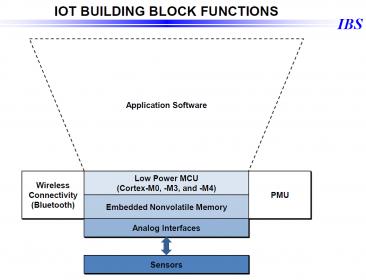No need to explain the IoT acronym (Internet of Things) except that IoT doesn’t really describe a reality: do you really know about any “Thing” being directly connected to the Internet? In fact, there is probably some intermediate system linking this thing with the Cloud, like a smartphone, an Internet box, a PC, etc. Just take a look at this picture below, more representative of the real life, showing the Aggregation Layers at the middle of IoT Edge Devices and Remote Processing.

Thus, why not calling a spade a spade, and the “IoT Edge Device” a Smart Connected Thing, or SmarCoT…
Smart because this thing really needs to be:
- Smart=CPU: integrating a CPU, which brings intelligence to the thing, will be key, but not necessarily a CPU delivering several 100’s MIPS, rather a few.
- Smart=Low Power: such a device needs to be power-aware, if not ultra-low-power. Do you really want to change or charge the battery every 5 days, or do we speak about several months if not years?
- Smart=Low Cost: we think that SmarCoT will become popular and lead to the expected 10 Billion devices only if the final price is in the $5 to 10 range, leaving a maximum of $1 to 3 for the Silicon content. By the way, better to target 65/55nm node, or even 180/130nm than 28nm or 16FF, to reach this price tag.
SmarCoT has to be connected because this is the concept foundation, which makes it attractive for the end user. It can be:
- WiFi, but the protocol is quite power hungry…
- ZigBee: the benefits are lower power (than WiFi or BlueTooth) and the mesh network capability, so you can build a complete personal area network, or use the mesh capability to reach more distant cell or base.
- Smart Bluetooth (or BTLE): provides the same low power capability than ZigBee. Moreover Bluetooth technology is widely developed, and Smart BlueTooth is coming at the right time, also offering mesh capability. In fact, the market will decide which of these protocol will become dominant, all will probably be used (but not in the same system, because of cost and power).
The last one, the “Thing”, can and will be absolutely anything, from a $300 watch targeting rich sportsmen to the $5 device still to be imagined.

Another point: the business model related to SmarCoT is still to be created. Most probably the success will come for the creative enterprises building a complete system and the related software, generating monthly subscription or fees, rather than to the IC maker. Thanks to Handel Jones from IBS, this slide presented to Shanghai SOI last fall illustrates the functional model: the sensors in contact with the real (analog) world are connected through analog interfaces to a low power MCU and the eNVM, processing whatever is to process, the complete system being connected through BlueTooth in this example. The Power Management Unit will be mandatory to manage the battery in a low power fashion.
What is the big piece on the above picture? Application software, and I would guess that this software will generate more revenue than the hardware!
So, are you SmarCoT or IoT?
This blog is not a poll… but feel free to give your opinion below.
From Eric Esteve from IPNEST
More Article From Eric Esteve







Comments
0 Replies to “Are you SmarCoT or IoT?”
You must register or log in to view/post comments.